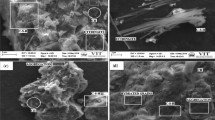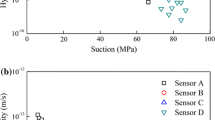Abstract
The producers of nuclear waste, within all countries exploring options, including Canada, have determined the long-term solution to be a deep geological repository. In the Canadian concept, within the deep geologic repository a number of clay-based barriers will separate the containers from the surrounding geosphere. Following placement the surrounding groundwater will infiltrate into the repository. In order to analyze the performance of the repository under very complex conditions, accurate material properties are required. The chemistry of the host rock is an important aspect as the behaviour of clay-based barrier materials could be affected by the saturating saline groundwater. This paper investigates the saturated mechanical behaviour of light backfill (composed of 50 % silica sand and 50 % Na-bentonite clay) and dense backfill (composed of 70 % crushed granite, 25 % glacial lake clay and 5 % Na-bentonite clay) and the quantifying the effect of pore fluid chemistry on the strength and compressibility behaviour of the materials. The results indicate that light backfill behaviour is strongly influenced by its pore fluid chemistry while dense backfill shows limited effects. The material parameters of light backfill and dense backfill are interpreted for input into numerical simulations. These results and interpretation enrich the understanding of the mechanical response of light and dense backfill, two components of the sealing system of the Canadian deep geologic repository.














Similar content being viewed by others
References
Anson RWW, Hawkins AB (1998) The effect of calcium ions in pore water on the residual shear strength of kaolinite and sodium montmorillonite. Géotechnique 48(6):787–800
ASTM (2004) Standard test method for consolidated undrained triaxial compression test for cohesive soils. ASTM standard D4767-04. American Society for Testing and Materials (ASTM), West Conshohocken, PA
Barbour SL, Yang N (1993) A review of the influence of clay–brine interactions on the geotechnical properties of Ca-montmorillonitic clayey soils from western Canada. Can Geotech J 30:920–934
Bjerrum L (1954) Geotechnical properties of Norwegian marine clays. Géotechnique 4:49–69
Blatz JA (2000) Elastic–plastic modeling of unsaturated high plastic clay using results from a new triaxial test with controlled suction. Ph.D. thesis, Department of Civil Engineering. The University of Manitoba, Winnipeg, MB
Blatz JA, Graham J (2003) Elastic plastic modelling of unsaturated high-plastic clay using results from a new triaxial test with controlled suction. Géotechnique 53(1):113–122
Blatz JA, Anderson D, Siemens GA (2007) Evaluation of elastic–plastic model parameters for two unsaturated compacted bentonite mixtures. Can Geotech J 44:436–446
Di Maio C (1996) Exposure of bentonite to salt solution: osmotic and mechanical effects. Géotechnique 46:695–707
Di Maio C, Fenelli GB (1994) Residual strength of kaolin and bentonite: the influence of their constituent pore fluid. Géotechnique 44(2):217–226
Gens A, Sánchez M, Do L, Guimarães N, Alonso EE, Lloret A, Olivella S, Villar MV, Huertas F (2009) A full-scale in situ heating test for high-level nuclear waste disposal: observations, analysis and interpretation. Géotechnique 59(4):377–399
Gierszewski P, Avis J, Calder A, D’Andrea A, Garisto F, Kitson C et al (2004) Third case study-post closure safety assessment. Ontario Power Generation, Toronto, Ontario Nuclear Waste Management Division Report 06819-REP-01200-10109-R00
Graham J (2006) The 2003 R.M. Hardy lecture: soil parameters for numerical analysis in clay. Can Geotech J 43:187–209
Graham J, Noonan ML, Lew KV (1983) Yield states and stress–strain relationships in a natural plastic clay. Can Geotech J 20:502–516
Graham J, Saadat F, Gray MN, Dixon DA, Zhang QY (1989) Strength and volume change behaviour of a sand–bentonite mixture. Can Geotech J 26:292–305
Graham J, Saadat F, Gray MN (1990) High-pressure triaxial testing on the Canadian reference buffer material. Eng Geol 28:391–403
Graham J, Oswell JM, Gray MN (1992) The effective stress concept in saturated sand–clay buffer. Can Geotech J 29:1033–1043
Johannesson L-E, Börgesson L, Goudarzi R, Sandén T, Gunnarsson D, Svemar C (2007) Prototype repository: a full scale experiment at Äspö HRL. Phys Chem Earth 32:58–76
Kenny TC (1967) The influence of mineral composition on the residual strength of natural soils. In: Proceedings of the geotechnical conference, Oslo, vol 1, pp 123–129
Man A, Graham J (2010) Pore fluid chemistry, stress–strain behaviour, and yielding in reconstituted highly plastic clay. Eng Geol 116:296–310
Matsuo S (1957) A study of the effect of cation exchange on the stability of slopes. In: Proceedings of 4th international conference on soil mechanics and foundation engineering, London, vol 1, pp 330–333
Mazurek M (2004) Long-term used nuclear fuel waste management. Geoscientific review of the sedimentary sequence in southern Ontario. Institute of Geological Sciences, University of Bern, Technical Report TR04-01, Bern Switzerland, available from Nuclear Waste Management Organisation, Toronto, Canada
Mitchell JK (1993) Fundamentals of soil behaviour, 2nd edn. Wiley, New York
Moore R (1991) The chemical and mineralogical controls upon the residual strength of pure and natural clays. Géotechnique 41:35–47
Moore R (1992) Discussion: the chemical and mineralogical controls upon the residual strength of pure and natural clays. Géotechnique 42:151–153
Moum J, Rosenqvist IT (1961) Mechanical properties of montmorillonite and illite clays related to electrolytes of the pore water. In: Proceedings of 5th international conference on soil mechanics and foundation engineering, Paris, vol 1, pp 263–267
NWMO (2005) Choosing a forward: the future management of Canada’s used nuclear fuel, final study. Annual Report, Nuclear Waste Management Organization, Toronto, Canada
Oswell JM (1991) Elastic plastic behaviour of a sand–bentonite mixture. Ph.D. thesis, Department of Civil Engineering, The University of Manitoba, Winnipeg, MB
Pearson FJ Jr (1985) Geochemical and isotopic evidence on the origin of brines in the Canadian Shield. Report by Intera Tech. Inc., Tex., for Atomic Energy of Canada Limited, WNRE, Pinawa, MB
Priyanto DG, Blatz JA, Siemens GA, Offman R, Powell JS, Dixon DA (2008) The effects of fluid composition on the one-dimensional consolidation behaviour of clay based sealing materials. Nuclear Waste Management Organization Report NWMO TR-2008-20. Toronto, Canada
Pusch R (2001) The buffer and backfill handbook, part 2: materials and techniques, SKB, TR-02-12. Stockholm
Ramiah BK, Dayalu NM, Purushothamaraj P (1970) Influence of chemicals on residual strength of silty clay. Soils Found 10:25–36
Romero E, Villar MV, Lloret A (2005) Thermo-hydro-mechanical behaviour of two heavily overconsolidated clays. Eng Geol 81:255–268
Rosenqvist ITh (1953) Considerations on the sensitivity of Norwegian quick clays. Géotechnique 3:195–200
Saadat F (1989) Consecutive modelling of the behaviour of a sand–bentonite mixture. Ph.D. thesis, Department of Civil Engineering, The University of Manitoba, Winnipeg, MB
Siddiqua S, Blatz J, Siemens G (2011a) Evaluation of the impact of pore fluid chemistry on the hydromechanical behaviour of clay-based sealing materials. Can Geotech J 48(2):199–213
Siddiqua S, Blatz J, Siemens G (2011b) Experimental study on the performance of light and dense backfills. Can Geotech J 48(2):214–225
Siemens GA, Blatz JA (2007) A triaxial apparatus for applying liquid infiltration with controlled boundary conditions and internal suction measurement. J Geotech Geoenviron Eng 133(6):748–752
Siemens GA, Blatz JA (2009) Evaluation of the influence of boundary confinement on the behaviour of unsaturated swelling clay soils. Can Geotech J 46(3):339–356
Skempton AW, Northey RD (1952) The sensitivity of clays. Géotechnique 1:1–30
Steward HE, Cripps JC (1983) Some engineering implications of chemical weathering of pyritic shale. Q J Eng Geol Hydrogeol 16:281–289
Sun BCC (1986) Stress–strain properties in sand–clay buffer materials. M.Sc. thesis, Department of Civil Engineering, The University of Manitoba, Winnipeg, MB
Tang GX (1999) Suction characteristics and elastic–plastic modelling of unsaturated sand–bentonite mixture, Ph.D. thesis, Department of Civil Engineering, The University of Manitoba, Winnipeg, MB
Tang GX, Graham J, Blatz J, Gray M, Rajapakse RKND (2002) Suctions, stresses and strengths in unsaturated sand–bentonite. Eng Geol 64:147–156
Tang CS, Tang AM, Cui YJ, Delage P, Schroeder C, Shi B (2011) A study of the hydro-mechanical behaviour of compacted crushed argillite. Eng Geol 118:93–103
Thomas HR, Cleall PJ, Chandler N, Dixon D, Mitchell HP (2003) Water infiltration into a large-scale in situ experiment in an underground research laboratory. Géotechnique 53(2):207–224
Villar MV, S’anchez M, Gens A (2008) Behaviour of a bentonite barrier in the laboratory: experimental results up to 8 years and numerical simulation. Phys Chem Earth 33:S476–S485
Wan AWL (1996) The use of thermocouple psychrometer to measure in situ suctions and water content in compacted clays. Ph.D. thesis, Department of Civil Engineering, The University of Manitoba, Winnipeg, MB
Warkentin BP, Yong RN (1962) Shear strength of montmorillonite and kaolinite. Clays Clay Miner 9:210–218
Winterkorn HF, Moorman RBB (1941) A study of changes in physical properties of Putnam soil induced by ionic substitution. In: Proceedings of highway research board, vol 21, pp 415–434
Yin JH (1990) Constitutive modelling of time-dependent stress–strain behaviour of soils. Ph.D. thesis, Department of Civil Engineering, The University of Manitoba, Winnipeg, MB
Yong RN, Mohamed AMO, Warkentin BP (1992) Principles of contaminant transport in soils. Elsevier, Amsterdam
Author information
Authors and Affiliations
Corresponding author
Rights and permissions
About this article
Cite this article
Siddiqua, S., Siemens, G., Blatz, J. et al. Influence of Pore Fluid Chemistry on the Mechanical Properties of Clay-Based Materials. Geotech Geol Eng 32, 1029–1042 (2014). https://doi.org/10.1007/s10706-014-9778-z
Received:
Accepted:
Published:
Issue Date:
DOI: https://doi.org/10.1007/s10706-014-9778-z




